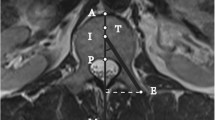Abstract
Percutaneous vertebroplasty (PVP) is carried out under fluoroscopic control in most centers. The exclusion of implant leakage and the assessment of implant distribution might be difficult to assess based on two-dimensional radiographic projection images only. We evaluated the feasibility of performing a follow-up examination after PVP with rotational acquisitions and volumetric reconstructions in the angio suite. Twenty consecutive patients underwent standard PVP procedures under fluoroscopic control. Immediate postprocedure evaluation of the implant distribution in the angio suite (BV 3000; Philips, The Netherlands) was performed using rotational acquisitions (typical parameters for the image acquisition included a 17-cm field-of-view, 200 acquired images for a total angular range of 180°). Postprocessing of acquired volumetric datasets included multiplanar reconstruction (MPR), maximum intensity projection (MIP), and volume rendering technique (VRT) images that were displayed as two-dimensional slabs or as entire three-dimensional volumes. Image evaluation included lesion and implant assessment with special attention given to implant leakage. Findings from rotational acquisitions were compared to findings from postinterventional CT. The time to perform and to postprocess the rotational acquisitions was in all cases less then 10 min. Assessment of implant distribution after PVP using rotational image acquisition methods and volumetric reconstructions was possible in all patients. Cement distribution and potential leakage sites were visualized best on MIP images presented as slabs. From a total of 33 detected leakages with CT, 30 could be correctly detected by rotational image acquisition. Rotational image acquisitions and volumetric reconstruction methods provided a fast method to control radiographically the result of PVP in our cases.



Similar content being viewed by others
References
Galibert P, Deramond H, Rosat P, et al. (1987) [Preliminary note on the treatment of vertebral angioma by percutaneous acrylic vertebroplasty]. Neurochirurgie 33(2):166–168
Martin JB, Jean B, Sugiu K, et al. (1999) Vertebroplasty: clinical experience and follow-up results. Bone 25(2 Suppl):11S–15S
Cotten A, Boutry N, Cortet B, et al. (1998) Percutaneous vertebroplasty: state of the art. Radiographics 18(2):311–320; discussion 320–323
Kallmes DF, Jensen ME (2003) Percutaneous vertebroplasty. Radiology 229(1):27–36
McGraw JK, Cardella J, Barr JD, et al. (2003) Society of interventional radiology quality improvement guidelines for percutaneous vertebroplasty. J Vasc Interv Radiol 14(9 Pt 2):S311–S315
Gangi A, Kastler BA, Dietemann JL (1994) Percutaneous vertebroplasty guided by a combination of CT and fluoroscopy. Am J Neuroradiol 15(1):83–86
Hochmuth A, Spetzger U, Schumacher M (2002) Comparison of three-dimensional rotational angiography with digital subtraction angiography in the assessment of ruptured cerebral aneurysms. Am J Neuroradiol 23(7):1199–1205
Gailloud P, Oishi S, Carpenter J, et al. (2004) Three-dimensional digital angiography: new tool for simultaneous three-dimensional rendering of vascular and osseous information during rotational angiography. Am J Neuroradiol 25(4):571–573
Martin JB, Gailloud P, Dietrich PY, et al. (2002) Direct transoral approach to C2 for percutaneous vertebroplasty. Cardiovasc Intervent Radiol 25(6):517–519
Garfin SR, Yuan HA, Reiley MA (2001) New technologies in spine: Kyphoplasty and vertebroplasty for the treatment of painful osteoporotic compression fractures. Spine 26(14):1511–1515
Cotten A, Dewatre F, Cortet B, et al. (1996) Percutaneous vertebroplasty for osteolytic metastases and myeloma: Effects of the percentage of lesion filling and the leakage of methyl methacrylate at clinical follow-up. Radiology 200(2):525–530
Mathis JM, Barr JD, Belkoff SM, et al. (2001) Percutaneous vertebroplasty: A developing standard of care for vertebral compression fractures. Am J Neuroradiol 22(2):373–381
Harrington KD (2001) Major neurological complications following percutaneous vertebroplasty with polymethylmethacrylate: A case report. J Bone Joint Surg Am 83-A(7):1070–1073
Kelekis AD, Martin JB, Somon T, et al. (2003) Radicular pain after vertebroplasty: compression or irritation of the nerve root? Initial experience with the “cooling system.” Spine 28(14):E265–E269
Linsenmaier U, Rock C, Euler E, et al. (2002) Three-dimensional CT with a modified C-arm image intensifier: Feasibility. Radiology 224(1):286–292
El-Sheik M, Heverhagen JT, Alfke H, et al. (2001) Multiplanar reconstructions and three-dimensional imaging (computed rotational osteography) of complex fractures by using a C-arm system: initial results. Radiology 221(3):843–849
Author information
Authors and Affiliations
Corresponding author
Rights and permissions
About this article
Cite this article
Hodek-Wuerz, R., Martin, JB., Wilhelm, K. et al. Percutaneous Vertebroplasty: Preliminary Experiences with Rotational Acquisitions and 3D Reconstructions for Therapy Control. Cardiovasc Intervent Radiol 29, 862–865 (2006). https://doi.org/10.1007/s00270-005-0193-y
Published:
Issue Date:
DOI: https://doi.org/10.1007/s00270-005-0193-y




